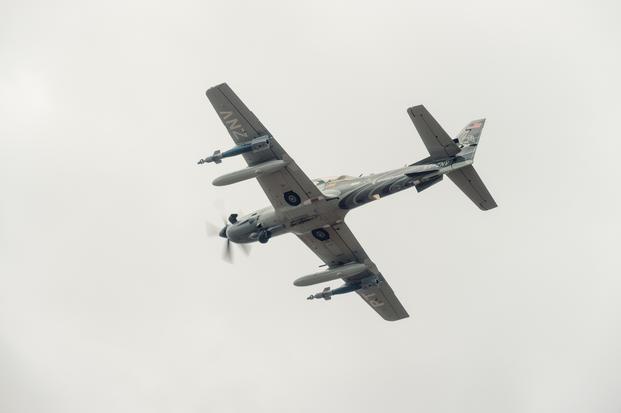A new Air Force investigation into the fatal crash of an Embraer-owned A-29 Super Tucano during testing last June found the Navy pilot executed a turn that ultimately sent the aircraft diving into the ground.
Lt. Christopher Carey Short was killed June 22, 2018, while flying the A-29 over Red Rio Bombing Range near Holloman Air Force Base, New Mexico, as part of the Air Force's light attack experiment. He died on impact after a delayed ejection initiation, shows the investigation, dated Oct. 4, 2018, and made public Friday. His weapons systems officer, an airman, ejected with what were described as minor injuries.
According to the investigation, the flight mission involved weapons delivery. Short was supposed to drop 500-pound GBU-12 Paveway II bombs and shoot rockets and .50-caliber ammunition over the range. It was during this process that the flight ran into challenges. The first weapon delivery was a Paveway II bomb from the left outboard pylon. Following the release of the munition, Short attempted a right, 180-degree turn.
"[Short exacerbated the [mishap aircraft's] right rolling tendency, caused by the GBU-12 release, by making the right aileron and rudder inputs while applying 1.47 positive g's," the report stated. "This resulted in a rapid roll to the right followed by an uncontrolled spiral dive."
The crew attempted four times to recover from the dive before giving up and attempting ejections.
The pilot's "overcontrol" of the aircraft resulted in it entering a dive, investigators found, and he also failed to "apply adequate recovery control inputs" after the dive had begun.
Moreover, the president of the investigation board found, the ejection seat selector had remained in "single" mode during the mishap. That and failures of communication among the crew "substantially contributed to the fatality," the board found.
The aircraft splintered on impact, roughly 30 minutes after the mishap flight began.
Short, an F/A-18 Hornet pilot by training who had 11 hours of flight time in the A-29 and more than 1,000 in the Hornet, was described as a well-qualified and mature pilot.
"[Light Attack Experiment] Flight leadership and fellow aircrew described [Short] as 'very professional in the aircraft' and as a 'wise soul, not prone to taking unnecessary risks,' " investigators wrote.
The different handling of the A-29, and flight operations on two different light attack contenders during the experiment, may have contributed to the crew's apparent miscalculation, the investigation indicates.
"An AT-6 [Wolverine] aircrew had flown the 180-degree turn eight days before the mishap," investigators said. "However, it was largely untested in the A-29, particularly at relatively slow airspeeds. The [mishap crew] made a wrong choice of action when they decided just prior to the initial weapon delivery to accept a slower than normal airspeed and proceed with the planned release, followed by a 180-degree turn in the direction of the heavy right wing, without compensating for the asymmetry."
Following the fatal crash, the Air Force halted its fly-off between the AT-6 and A-29 in order to stand up a safety board. While officials said at the time that the crash would not spell the end of the service's light attack effort, planning has since stalled.
It's not clear whether the Air Force plans to resume its pursuit of a light attack aircraft fleet.
-- Hope Hodge Seck can be reached at hope.seck@military.com. Follow her on Twitter at @HopeSeck.










